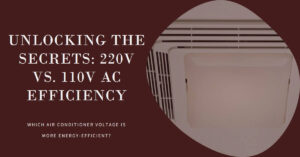Voltage is a crucial component of our electrical systems, and its stability plays a significant role in ensuring the proper functioning of our appliances and devices.
Insufficient voltage can cause electrical equipment to malfunction, potentially leading to performance issues, damage to sensitive components, and increased safety risks.
This article explores the effects of low voltage, potential risks and hazards, common causes, and practical solutions to address this problem.
Understanding Voltage
Voltage, measured in volts (V), refers to the electrical potential difference between two points in a circuit.
It is responsible for the flow of electric current, powering our homes, offices, and industries. Electrical systems operate within specific voltage ranges to maintain efficiency and safety.
Effects of Low Voltage
Low voltage can have several adverse effects on our electrical systems and devices. It is important to be aware of these consequences to prevent potential damage and ensure optimal performance.
Voltage Drop
One of the primary effects of low voltage is a voltage drop. This occurs when the voltage decreases significantly from the expected or required level due to various factors such as long wiring distances or high electrical demand.
Voltage drop can lead to decreased power quality and performance issues throughout the system.
Malfunctioning of Electrical Equipment
Low voltage can cause malfunctioning of electrical equipment, leading to performance degradation and potential failures. Some common issues include:
Dimming Lights
When voltage drops, lights may dim or flicker, affecting visibility and overall lighting quality. This can be particularly noticeable during peak demand periods or in areas with aging electrical infrastructure.
Motor Issues
Motors in appliances, machinery, and HVAC systems rely on adequate voltage to function optimally. Insufficient voltage can cause motors to run at lower speeds, overheat, or even fail to start.
This can lead to decreased efficiency, increased energy consumption, and costly repairs or replacements.
Read also my article: Voltage Woes: Can Low Voltage Damage Your Fan?
Heating and Cooling Problems
Low voltage can impact heating and cooling systems, affecting their ability to regulate temperatures effectively.
HVAC systems may struggle to reach the desired temperature, resulting in discomfort and increased energy usage.
Impact on Electronics
Low voltage can pose significant risks to sensitive electronic devices and components, potentially leading to irreversible damage or data loss.
Damage to Sensitive Components
Electronics such as computers, servers, and delicate control systems rely on stable voltage levels to function properly.
Inadequate voltage can cause overheating, component stress, and even failure, resulting in costly repairs or data corruption.
Inaccurate Readings and Data Loss
Electrical equipment and measuring devices may provide inaccurate readings if the voltage is too low. This can lead to faulty data collection, unreliable analyses, and potential errors in critical systems.
Read also my article: The Silent Threat: Can Low Voltage Damage Your Electronics?
Risks and Hazards
Low voltage also brings certain risks and hazards that can compromise safety and result in additional complications.
Fire Hazards
Low voltage can cause electrical systems to overload, leading to overheating and potentially sparking fires. Damaged wires, loose connections, and other electrical faults are more likely to occur when the voltage is too low, increasing the risk of fire hazards.
Electrical Shock
In some cases, low voltage can make electrical systems unpredictable and less reliable. This unpredictability increases the risk of electrical shock, which can be dangerous and even life-threatening.
Overloading and Overheating
When voltage is insufficient, electrical systems may struggle to meet the demand placed on them. This can lead to overloading of circuits, resulting in overheating of wires, components, and other electrical infrastructure. Overheating poses the risk of equipment damage, increased energy consumption, and fire hazards.
Causes of Low Voltage
Several factors contribute to low voltage situations. Identifying the root cause is crucial to finding appropriate solutions and preventing future occurrences.
Utility-related Factors
Issues within the power grid or transformer malfunctions can lead to low voltage. Overloaded transformers, damaged power lines, or inadequate power generation and distribution can all result in voltage fluctuations.
Wiring and Connection Problems
Problems with wiring and connections are common causes of low voltage at specific points within electrical systems. Loose connections, corroded wires, or faulty wiring can lead to voltage drops.
High Demand or Heavy Load Situations
During peak usage periods or when the electrical load exceeds the capacity of the system, the voltage can drop.
This often happens in commercial or industrial settings, where heavy machinery or equipment demands significant power.
Troubleshooting and Solutions
To address low voltage issues, it is essential to troubleshoot and implement appropriate solutions.
Checking Voltage Levels
Regularly monitoring voltage levels using a voltmeter can help identify any potential low-voltage situations. If voltage drops persist, consulting with a professional electrician is recommended.
Consulting with Professionals
If low voltage issues persist or if the cause is not apparent, it is advisable to consult with a licensed electrician.
They can perform a thorough evaluation of the electrical system, identify the underlying problems, and provide suitable solutions.
Installing Voltage Stabilizers or UPS Systems
Voltage stabilizers or uninterruptible power supply (UPS) systems can help mitigate low voltage issues by regulating and stabilizing voltage levels.
These devices monitor the incoming voltage and provide consistent power to protect sensitive electronics and prevent damage.
Maintaining Electrical Systems
Regular maintenance and inspection of electrical systems can help identify potential issues before they cause low-voltage problems.
Ensuring proper wiring, secure connections, and adequate capacity can go a long way in preventing voltage drops.
Conclusion
Low voltage can have detrimental effects on our electrical systems, leading to malfunctioning equipment, potential risks, and hazards.
Understanding the causes and consequences of low voltage is crucial for maintaining the safety and efficiency of our electrical infrastructure.
By monitoring voltage levels, addressing wiring and connection problems, and seeking professional assistance when needed, we can mitigate low voltage issues and ensure reliable electrical performance.

